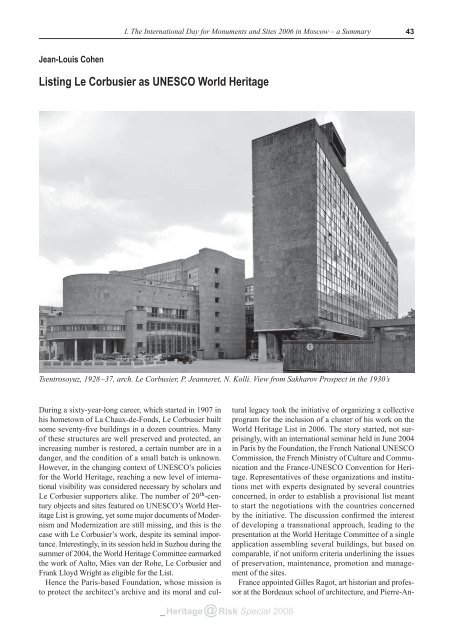The Soviet Heritage and European Modernism - Heritage ... - Icomos
The Soviet Heritage and European Modernism - Heritage ... - Icomos
The Soviet Heritage and European Modernism - Heritage ... - Icomos
You also want an ePaper? Increase the reach of your titles
YUMPU automatically turns print PDFs into web optimized ePapers that Google loves.
I. <strong>The</strong> International Day for Monuments <strong>and</strong> Sites 2006 in Moscow – a Summary<br />
43<br />
Jean-Louis Cohen<br />
Listing Le Corbusier as UNESCO World <strong>Heritage</strong><br />
Tsentrosoyuz, 1928 –37, arch. Le Corbusier, P. Jeanneret, N. Kolli. View from Sakharov Prospect in the 1930’s<br />
During a sixty-year-long career, which started in 1907 in<br />
his hometown of La Chaux-de-Fonds, Le Corbusier built<br />
some seventy-five buildings in a dozen countries. Many<br />
of these structures are well preserved <strong>and</strong> protected, an<br />
increasing number is restored, a certain number are in a<br />
danger, <strong>and</strong> the condition of a small batch is unknown.<br />
However, in the changing context of UNESCO’s policies<br />
for the World <strong>Heritage</strong>, reaching a new level of international<br />
visibility was considered necessary by scholars <strong>and</strong><br />
Le Corbusier supporters alike. <strong>The</strong> number of 20 th -century<br />
objects <strong>and</strong> sites featured on UNESCO’s World <strong>Heritage</strong><br />
List is growing, yet some major documents of <strong>Modernism</strong><br />
<strong>and</strong> Modernization are still missing, <strong>and</strong> this is the<br />
case with Le Corbusier’s work, despite its seminal importance.<br />
Interestingly, in its session held in Suzhou during the<br />
summer of 2004, the World <strong>Heritage</strong> Committee earmarked<br />
the work of Aalto, Mies van der Rohe, Le Corbusier <strong>and</strong><br />
Frank Lloyd Wright as eligible for the List.<br />
Hence the Paris-based Foundation, whose mission is<br />
to protect the architect’s archive <strong>and</strong> its moral <strong>and</strong> cultural<br />
legacy took the initiative of organizing a collective<br />
program for the inclusion of a cluster of his work on the<br />
World <strong>Heritage</strong> List in 2006. <strong>The</strong> story started, not surprisingly,<br />
with an international seminar held in June 2004<br />
in Paris by the Foundation, the French National UNESCO<br />
Commission, the French Ministry of Culture <strong>and</strong> Communication<br />
<strong>and</strong> the France-UNESCO Convention for <strong>Heritage</strong>.<br />
Representatives of these organizations <strong>and</strong> institutions<br />
met with experts designated by several countries<br />
concerned, in order to establish a provisional list meant<br />
to start the negotiations with the countries concerned<br />
by the initiative. <strong>The</strong> discussion confirmed the interest<br />
of developing a transnational approach, leading to the<br />
presentation at the World <strong>Heritage</strong> Committee of a single<br />
application assembling several buildings, but based on<br />
comparable, if not uniform criteria underlining the issues<br />
of preservation, maintenance, promotion <strong>and</strong> management<br />
of the sites.<br />
France appointed Gilles Ragot, art historian <strong>and</strong> professor<br />
at the Bordeaux school of architecture, <strong>and</strong> Pierre-An-<br />
_ <strong>Heritage</strong> @ Risk Special 2006

















